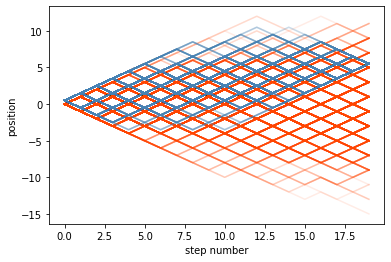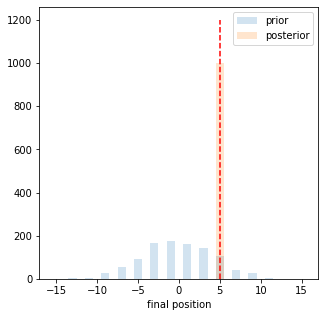Universal Probabilistic Programming Example¶
by Lukas Heinrich
Markov Chains are sequences of random variables, where the value of the current sequence index only depends on the value just before it. Given a current position, the next position is simply defined by a probability distribution p(z,z’).
Here we look at a Markov Chain starting at [0,0], which at each point can make exactly two moves “up” and “down”.
If you just let the Markov Chain run freely, we will it be after 10 iteratinos? or 20? or 100? You might have heard about the Galton Board.
Before we start, we will import some libraries as always
import pyprob
%matplotlib inline
import matplotlib.pyplot as plt
from pyprob import Model
import numpy as np
import math
import pyprob
from pyprob import Model
from pyprob.distributions import Normal, Uniform, Categorical
import torch
import IPython
Warning: Empirical distributions on disk may perform slow because GNU DBM is not available. Please install and configure gdbm library for Python for better speed.
IPython.display.Image(url = 'https://thumbs.gfycat.com/QuaintTidyCockatiel-max-1mb.gif')

Implementing the Galton Board in Code¶
we will have a Galton board with 20 steps. At each step the position can move either up and down in a fair way.
class MarkovChainPath(Model):
def __init__(self):
super().__init__(name="Markov Chain Path") # give the model a name
def forward(self): # Needed to specifcy how the generative model is run forward
# sample the (latent) mean variable to be inferred:
coords = [[0,0]]
moves = {0: -1, 1: 1, 2: 1}
for i in range(1,20):
last = coords[-1][1]
move = pyprob.sample(Categorical([1/2.,1/2.]), name = 'input{}'.format(i))
move = moves[move.item()]
coords.append([i,last+move])
obs_distr = Normal(coords[-1][1], 0.1)
pyprob.observe(obs_distr, name='obs0') # NOTE: observe -> denotes observable variables
return coords
model = MarkovChainPath()
Learning to Guide the Chain¶
As usual we will be training our inference network!
model.learn_inference_network(
num_traces=10000,
observe_embeddings={'obs0': {'dim': 100, 'depth': 5}}
)
Creating new inference network...
Observable obs0: observe embedding not specified, using the default FEEDFORWARD.
Observe embedding dimension: 100
Train. time | Epoch| Trace | Init. loss| Min. loss | Curr. loss| T.since min | Traces/sec
New layers, address: 74__forward__move__Categorical(len_probs:2)__1, distribution: Categorical
New layers, address: 74__forward__move__Categorical(len_probs:2)__2, distribution: Categorical
New layers, address: 74__forward__move__Categorical(len_probs:2)__3, distribution: Categorical
New layers, address: 74__forward__move__Categorical(len_probs:2)__4, distribution: Categorical
New layers, address: 74__forward__move__Categorical(len_probs:2)__5, distribution: Categorical
New layers, address: 74__forward__move__Categorical(len_probs:2)__6, distribution: Categorical
New layers, address: 74__forward__move__Categorical(len_probs:2)__7, distribution: Categorical
New layers, address: 74__forward__move__Categorical(len_probs:2)__8, distribution: Categorical
New layers, address: 74__forward__move__Categorical(len_probs:2)__9, distribution: Categorical
New layers, address: 74__forward__move__Categorical(len_probs:2)__10, distribution: Categorical
New layers, address: 74__forward__move__Categorical(len_probs:2)__11, distribution: Categorical
New layers, address: 74__forward__move__Categorical(len_probs:2)__12, distribution: Categorical
New layers, address: 74__forward__move__Categorical(len_probs:2)__13, distribution: Categorical
New layers, address: 74__forward__move__Categorical(len_probs:2)__14, distribution: Categorical
New layers, address: 74__forward__move__Categorical(len_probs:2)__15, distribution: Categorical
New layers, address: 74__forward__move__Categorical(len_probs:2)__16, distribution: Categorical
New layers, address: 74__forward__move__Categorical(len_probs:2)__17, distribution: Categorical
New layers, address: 74__forward__move__Categorical(len_probs:2)__18, distribution: Categorical
New layers, address: 74__forward__move__Categorical(len_probs:2)__19, distribution: Categorical
Total addresses: 19, parameters: 132,895
0d:00:00:47 | 1 | 10,048 | +1.32e+01 | +1.23e+01 | +1.27e+01 | 0d:00:00:29 | 216.0
Generating Prior and Posterior Traces¶
As in the other examples we have prior and posterior traces. What will they look like? Have a guess.
prior = model.prior(
num_traces=1000,
)
Time spent | Time remain.| Progress | Trace | Traces/sec
0d:00:00:04 | 0d:00:00:00 | #################### | 1000/1000 | 229.92
We will also generate some sampled from the conditioned model. Feel free to change the condition value from 5 to a number you like.
condition = {'obs0': 5}
posterior = model.posterior(
num_traces=1000,
inference_engine=pyprob.InferenceEngine.IMPORTANCE_SAMPLING_WITH_INFERENCE_NETWORK,
observe=condition
)
Time spent | Time remain.| Progress | Trace | Traces/sec
0d:00:00:18 | 0d:00:00:00 | #################### | 1000/1000 | 53.91
Let’s get a representative set of paths for both the conditioned model as well as the unconditioned one
post_paths = [posterior.sample().result for i in range(1000)]
prior_paths = [prior.sample().result for i in range(1000)]
The Plots!¶
As expected the conoditioned paths always arrive at the same spot, no matter where they wandered off to in the middle of their path. At some point the proposals from the agent will steer it in the correct direction.
We can also plot the final position distribution. As expected the unconditinoed one follows a normal distribution while the conditioned one, is basically a delta distribution on the conditioned value
for p in prior_paths:
p = np.asarray(p)
plt.plot(p[:,0],p[:,1], c = 'orangered', alpha = 0.1)
for p in post_paths:
p = np.asarray(p)
plt.plot(p[:,0],p[:,1] + 0.5, c = 'steelblue', alpha = 0.1, )
plt.xlabel('step number')
plt.ylabel('position')
Text(0, 0.5, 'position')

c1,_,_ = plt.hist([p[-1][1] for p in prior_paths], np.linspace(-15.5,15.5,32), alpha = 0.2, label = 'prior');
c2,_,_ = plt.hist([p[-1][1] for p in post_paths], np.linspace(-15.5,15.5,32), alpha = 0.2, label = 'posterior');
plt.vlines(condition['obs0'],0,np.max([c1.max(),c2.max()])*1.2, linestyle = 'dashed', color = 'red')
plt.legend()
plt.gcf().set_size_inches(5,5)
plt.xlabel('final position')
Text(0.5, 0, 'final position')

